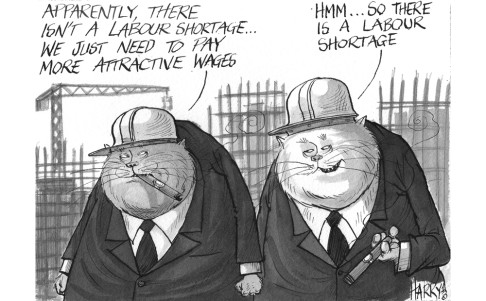
Industry leaders warn of serious manpower shortage in Hong Kong
City's workforce problem more serious than the government thinks, say representatives of three key sectors already facing labour shortfalls
Hong Kong is facing a far greater manpower shortage than reflected in official projections, according to industry leaders, who fear that government policies will fail to tackle the crisis.
They say the shortfall amounts to tens of thousands of workers in three key sectors identified recently by the government and argue that the labour importation scheme is too rigid and time-consuming. It should either be reformed, or the government should set up a new scheme.
Last month Chief Secretary Carrie Lam Cheng Yuet-ngor said construction, food services and homes for the elderly faced immediate manpower shortages when she launched a consultation to tackle challenges arising from the ageing population.
Representatives from the three industries told the they feared the government may not have grasped the urgency of the manpower problem.
"I am very worried … if [the government] cannot see the problem the industry is facing, it may make a wrong decision," said Thomas Ho On-sing, president of the Hong Kong Construction Association and chief executive of Gammon Construction.
Figures from the Census and Statistics Department showed there were 82,542 construction site workers across the city as of June, with 1,025 vacancies. A report last year projected that manpower demand would rise by 1.9 per cent on average each year up to 2018.
But Ho said a survey by his association several months ago found a vacancy rate of 15 per cent - meaning a shortfall of more than 10,000 workers.
"A cement mixer with no experience is getting paid HK$1,100 a day. If the demand for workers only goes up by about 1.9 per cent a year, why would they get paid this much?" he said.
He said government expenditure on infrastructure projects had soared from about HK$20 billion in 2008 to HK$70 billion this year, which should have shed light on the pace of manpower demand.
Simon Wong Ka-wo, president of the Federation of Restaurants and Related Trades, said the food services industry needed 24,000 workers on top of the 240,000 employed now. But the census figures said there were only 11,364 vacancies as of June.
"In the past, a waiter got paid only HK$35 an hour. Now it is difficult to hire one even if you are offering HK$60," Wong said.
He said the number of restaurants had been rising by about 5 per cent a year, and manpower demand should follow this pace. But that's a far cry from the government's projection of 1.3 per cent in the "accommodation and food services" sector.
"The projection is too conservative. It's time for the government to be bold when it plans policies," Wong said.
The chairman of the Elderly Services Association of Hong Kong, Kenneth Chan Chi-yuk, said the city's 500 homes for the elderly needed 5,000 staff on top of the 20,000 already working. Yet census statistics showed there were 2,102 vacancies as of June, up from 855 three years ago.
Chan expressed concern that there was no projection for this industry in the 2018 manpower report. "I have always been worried. The government should pledge that a certain percentage of old people will be getting a place in subsidised homes. It needs long-term planning to tackle the problem," he said.
The census department and the Labour and Welfare Bureau said in a joint reply that the statistical framework adopted in compiling the job vacancies followed international guidelines of the United Nations and the International Labour Organisation.
They said some employers may not be recruiting because they believe they cannot find the right people. Such unfilled posts are therefore not regarded as vacancies, the reply said.
As for the 2018 manpower report, it was compiled with reference to a wide range of statistics, including employers' views on their future manpower requirements collected from a survey, and extensive consultation with business, trade associations and academics.


